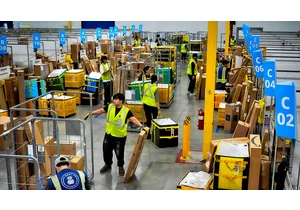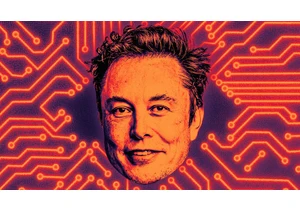Welcome to AI Decoded, Fast Company’s weekly newsletter that breaks down the most important news in the world of AI. You can sign up to receive this newsletter every week here.
Inside the new Grok 3 model
In just two years, Elon Musk’s xAI has become one of a dozen or so labs capable of developing state-of-the-art AI models. Now xAI is out with its Grok 3 large language model, which beats state-of-the-art frontier models, such as OpenAI’s GPT-4o and DeepSeek’s V3, in common mathematics, science, and coding benchmarks by a wide margin. Meanwhile, the smaller Grok 3-mini performs at par with the larger competing models.
The new Grok model reportedly was trained using unprecedented computing power—first with a cluster of 100,000 Nvidia H100 GPUs. A small group of rival developers have been testing an early version of Grok 3, and most say they’re impressed, with some caveats. OpenAI cofounder Andrej Karpathy posted on X that Grok 3 exhibited sharp reasoning skills and was able to resolve some complex problems. He estimates that the model is on par with OpenAI’s o1-Pro reasoning model and slightly better than DeepSeek-R1 and Google’s Gemini 2.0 Flash Thinking.
However, he did find that Grok 3 choked on some prompts commonly known to give large transformer models trouble, such as determining how many Ls are in “Lollapalooza,” for example. Scale AI CEO Alexandr Wang posted on X that Grok 3 is a state-of-the-art model and gives it props for achieving the top spot on the Chatbot Arena benchmark. Whereas AI skeptic Gary Marcus, who also posted on X, said that while Grok 3 shows real progress, it doesn’t represent a significant leap beyond existing models.
More benchmark test scores will surface in the coming days and weeks to provide a fuller picture of how Grok 3 stacks up against the competition. Impressive as that is, the development of new “thinking” models is now moving so fast that Grok 3 could disappear back into the pack of benchmark performers three months from now. AI labs are only now learning how to scale up the computing power that “thinking” models use after being presented with a problem. Upcoming models from OpenAI, Anthropic, Google, DeepSeek, and others will show the fruits of that research.
Brookings: The AI revolution’s winners and losers won’t be who or where you’d think
A new Brookings Institution analysis of AI’s effects on jobs and job losses suggests highly educated urban workers will be most at risk of losing their jobs.
The last industrial revolution mainly affected lower-wage manufacturing and service jobs in smaller towns and rural areas. This time around, it’ll be knowledge workers in tech hubs and financial centers who will face the greatest exposure to AI-driven change.
In San Jose’s Santa Clara County, Brookings found that nearly 43% of workers could see half or more of their tasks transformed by AI tools including OpenAI’s ChatGPT and Anthropic’s Claude. Meanwhile, workers in less tech-oriented regions like Las Vegas would see less than a third of their tasks altered by AI tools. This pattern holds true across the nation, with major disparities even within states: California’s exposure rates range from 42.8% in tech-heavy Santa Clara County to just 26.7% in rural Mono County.
It’s not so surprising when one looks at the technology itself, according to Brookings’s report. Factory-floor machinery was meant to replace repetitive physical tasks, while generative AI specializes in cognitive work: writing, analysis, coding, and other knowledge-based tasks. The more education and higher wages a job requires, the more likely it is to be touched by AI capabilities.
Brookings, a D.C.-based policy think tank, says lawmakers should be thinking about ways of protecting the jobs of urban-knowledge workers, and “reskilling” them, while ensuring that rural areas aren’t left behind in accessing AI’s productivity benefits. The geography of technological disruption has been rewritten, the think tank says, and the implications for workforce development and economic inequality are only just beginning to emerge.
Ex-OpenAI Mira Murati unveils AI startup, but its focus remains vague
Former OpenAI CTO Mira Murati has unveiled her new AI company, Thinking Machines Lab. While the product the startup intends to build remains unclear, Murati apparently intends to build AI in a very different way than her former company—out in the open.
The AI research community used to be a fairly chatty place, but the research breakthroughs that led to ChatGPT soon attracted a lot of money—and with big money comes more secrecy. So, while companies such as OpenAI and Anthropic closely guard their training methods, Murati said in a blog post that Thinking Machines will regularly publish its technical insights, research papers, and code. If DeepSeek is any guide (it open-sourced its models and published its research methods), this practice could intensify the race toward the industry’s goal of creating artificial general intelligence (that is, AI that’s generally smarter than humans).
Murati’s blog post also expresses an intent to create models that can be more easily steered toward specific applications in specific subject areas. AI systems remain “difficult for people to customize to their specific needs and values,” Murati wrote. She said her company will build systems that are “more widely understood, customizable, and generally capable.”
The Information reports that more than two-thirds of the researchers at Murati’s company come from OpenAI, including OpenAI cofounder John Schulman and former head of safety Lilian Weng. The startup intends to build systems that assist humans, not replace them. “Instead of focusing solely on making fully autonomous AI systems, we are excited to build multimodal systems that work with people collaboratively,” Murati wrote. “We see enormous potential for AI to help in every field of work.”
Beyond that, little is known about what Thinking Machines Lab will build. Based on Murati’s background and statements, it seems likely that the company will focus on very large foundation models that can be trained or adapted to many different specialized tasks.
Meanwhile, Bloomberg reports that another OpenAI alum, cofounder Ilya Sutskever, is in talks to raise more than $1 billion in funding in a round that could value his AI startup, Safe Superintelligence, at more than $30 billion.
More AI coverage from Fast Company:
- This AI tool could help curb domestic violence
- This AI trend lets TikTok users relive history’s best—and worst—moments
- How to use AI to find new movies, music, and books
- AI hallucinations could get lawyers fired, one law firm says
Want exclusive reporting and trend analysis on technology, business innovation, future of work, and design? Sign up for Fast Company Premium.
Zaloguj się, aby dodać komentarz
Inne posty w tej grupie

Amazon is extending its annual Prime Day sales and offering new membership perks to Ge

How would you spend $342 billion?
A number of games called “Spend Elon Musk’s Money” have been popping up online, inviting users to imagine how they’d blow through the

On Tuesday, AI lab Moonvalley

As Elon Musk announced plans over the Fourth of July weekend to establish a third political party,

Dolores Ballesteros, a Mexico-based mother of two, was getting desperate. Her 6-year-old son kept hitting his brother, age 3, and seemed angry at her all the time. No matter what she did, she coul

Rarely has Silicon Valley experienced a more profound period of transformation than it has in the past handful of years. The big VC boom of 2020–2021. The great VC hangover starting in 2022. The g
